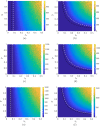Activity-driven network modeling and control of the spread of two concurrent epidemic strains
- PMID: 36186912
- PMCID: PMC9514203
- DOI: 10.1007/s41109-022-00507-6
Activity-driven network modeling and control of the spread of two concurrent epidemic strains
Abstract
The emergency generated by the current COVID-19 pandemic has claimed millions of lives worldwide. There have been multiple waves across the globe that emerged as a result of new variants, due to arising from unavoidable mutations. The existing network toolbox to study epidemic spreading cannot be readily adapted to the study of multiple, coexisting strains. In this context, particularly lacking are models that could elucidate re-infection with the same strain or a different strain-phenomena that we are seeing experiencing more and more with COVID-19. Here, we establish a novel mathematical model to study the simultaneous spreading of two strains over a class of temporal networks. We build on the classical susceptible-exposed-infectious-removed model, by incorporating additional states that account for infections and re-infections with multiple strains. The temporal network is based on the activity-driven network paradigm, which has emerged as a model of choice to study dynamic processes that unfold at a time scale comparable to the network evolution. We draw analytical insight from the dynamics of the stochastic network systems through a mean-field approach, which allows for characterizing the onset of different behavioral phenotypes (non-epidemic, epidemic, and endemic). To demonstrate the practical use of the model, we examine an intermittent stay-at-home containment strategy, in which a fraction of the population is randomly required to isolate for a fixed period of time.
Keywords: Bi-virus; Complex networks; Control; Epidemics; Temporal network.
© The Author(s) 2022.
Conflict of interest statement
Competing interestsThe authors declare that they have no competing interests.
Figures




Similar articles
-
Modeling latent infection transmissions through biosocial stochastic dynamics.PLoS One. 2020 Oct 23;15(10):e0241163. doi: 10.1371/journal.pone.0241163. eCollection 2020. PLoS One. 2020. PMID: 33095815 Free PMC article.
-
#stayhome to contain Covid-19: Neuro-SIR - Neurodynamical epidemic modeling of infection patterns in social networks.Expert Syst Appl. 2021 Mar 1;165:113970. doi: 10.1016/j.eswa.2020.113970. Epub 2020 Sep 3. Expert Syst Appl. 2021. PMID: 32908331 Free PMC article.
-
Epidemic spreading with activity-driven awareness diffusion on multiplex network.Chaos. 2016 Apr;26(4):043110. doi: 10.1063/1.4947420. Chaos. 2016. PMID: 27131489 Free PMC article.
-
How adherence to public health measures shapes epidemic spreading: A temporal network model.Chaos. 2021 Apr;31(4):043115. doi: 10.1063/5.0041993. Chaos. 2021. PMID: 34251238
-
Simulation and forecasting models of COVID-19 taking into account spatio-temporal dynamic characteristics: A review.Front Public Health. 2022 Oct 18;10:1033432. doi: 10.3389/fpubh.2022.1033432. eCollection 2022. Front Public Health. 2022. PMID: 36330112 Free PMC article. Review.
Cited by
-
Exploring a COVID-19 Endemic Scenario: High-Resolution Agent-Based Modeling of Multiple Variants.Adv Theory Simul. 2023 Jan;6(1):2200481. doi: 10.1002/adts.202200481. Epub 2022 Nov 11. Adv Theory Simul. 2023. PMID: 36718198 Free PMC article.
References
-
- Aleta A, Martin-Corral D, Pastorey Piontti A, Ajelli M, Litvinova M, Chinazzi M, Dean NE, Halloran ME, Longini IM, Jr, Merler S, et al. Modelling the impact of testing, contact tracing and household quarantine on second waves of COVID-19. Nat Hum Behav. 2020;4(9):964–971. doi: 10.1038/s41562-020-0931-9. - DOI - PMC - PubMed
-
- Arenas A, Cota W, Gómez-Gardeñes J, Gómez S, Granell C, Matamalas JT, Soriano-Paños D, Steinegger B. Modeling the spatiotemporal epidemic spreading of COVID-19 and the impact of mobility and social distancing interventions. Phys Rev X. 2020;10:041055.
LinkOut - more resources
Full Text Sources
